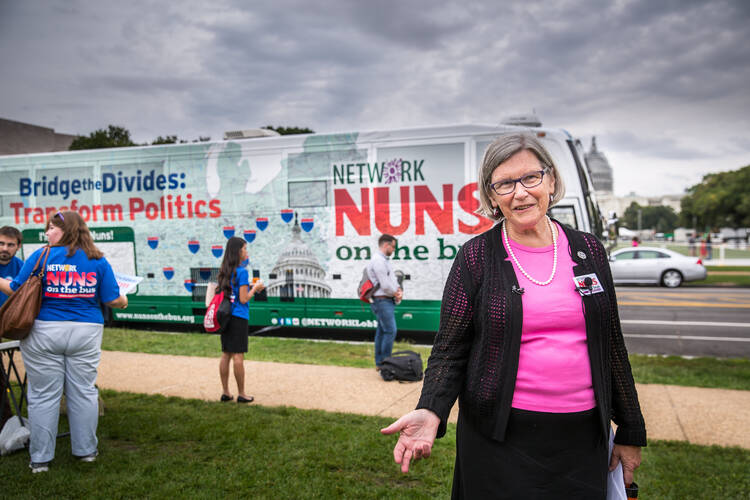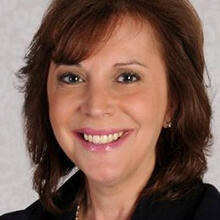They stopped for lunch in Peru, Ill., at an independently owned pizza parlor that they made sure had a fair wage and other worker-friendly policies. Then it was on to Bloomington, where they toured a day care program at the Y.W.C.A. of McLean County and spoke with immigrants, immigration lawyers and public health care providers. At night, they told a group of about 90 people gathered at the Unitarian Universalist Church—many of them Catholic—that our current tax code “isn’t working” for the poor.
Welcome to the Nuns on the Bus tour 2016.
As they did in 2012, a group of Catholic sisters are traveling the country, speaking out on behalf of the poor and marginalized in the lead-up to the presidential election. The tour is once again being organized by Sister Simone Campbell, S.S.S., executive director of Network, a social action group in Washington, D.C. Campbell galvanized the Democratic National Convention four years ago with her deeply personal address focusing on the needs of the poor.
I spent a whirlwind day with the nuns as they made stops in Illinois en route to this year’s presidential conventions. “We are on the road in response to the divisive rhetoric of the 2016 election cycle and as an answer to Pope Francis’ call that a healthy politics is sorely needed,” Sister Simone told me.
Their theme this year is “Mend the Gaps: Reweave the Fabric of Society.” Wherever they go, the nuns talk about a living wage for workers, access to health care for all, affordable housing, a pathway to citizenship for undocumented immigrants, family-friendly workplace policies and tax reform that alleviates the burden on the poor and middle class.
Of the widening gap between rich and poor, Sister Simone asks, “How did we get into this mess? We discovered at Network that it was policies, conscious policy choices made in the late ’70s and early ’80s that resulted in this huge wealth and income disparity. And we realized if policies created the gaps, policies can change the gaps.”
The sisters say they plan to do as much listening as talking. In an effort to address political polarization, they are asking delegates at both conventions a series of questions about their concerns to determine areas of agreement between both political parties.
“We are going to compare notes to see where we meet as a nation. I have a hunch [the hopes of both group of delegates] will be quite similar,” Sister Simone says. “I call us equal opportunity annoyers. I’ll annoy the Democrats and I’ll annoy the Republicans to care for those we advocate for.” This week, the sisters have been invited to give three workshops on social concerns as the Democrats meet in Philadelphia.
Sister Simone described the Nuns on the Bus as “Pope Francis voters” and says there is room for improvement in both parties’ platforms when it comes to serving the nation’s most vulnerable citizens.
“Pope Francis, when he visited the United States, spoke strongly about the importance of being involved in politics, but in a way that brings the needs of those most exploited and marginalized into the conversation,” she says.
“Speaking for those who struggle and are exploited means we can’t be loyal to just one party, because no one party embodies all good policies. We have to be faithful to the people.”
The day I traveled with the sisters, members on the bus included the Sisters of Mercy, Dominicans of Peace, Sisters of St. Joseph, Sisters of Notre Dame de Namur, Ursulines, Franciscans, Daughters of Charity, Sisters of the Holy Family, Comboni Missionary Sisters and Sisters of St. Agnes. Sister Simone is a member of the Sisters of Social Service.
This year’s contingent of nuns includes five attorneys, a psychologist, a licensed clinical social worker, educators, pastoral associates and social workers.
Their colorful bus is hard to miss as it lumbers along highways and rolls into cities. Its sides are emblazoned with the “Nuns on the Bus” logo, as well as a quote from Pope Francis and a map of their 2016 tour route, which will take them to 13 states in the Midwest and Northeast. Inside there are two rows of leather swivel chairs, a small kitchen to keep snacks and brew coffee, a tiny conference table and a big-screen TV the nuns say they don’t have time to watch.
“It’s pretty fancy. It’s not something we’re used to, but for such a long ride it’s good to have comfortable seats,” Sister Simone says.
Their day begins with prayer, says Sister Susan Francois of Englewood Cliffs, N.J., and includes “listening to where God might be speaking to us through the people we meet, through the Scripture of the day and just being open to the experience of being together and forming community.”
Much of their time on the bus is spent emailing, giving social media updates on their tour and practicing their talking points for when they hold “caucuses” with members of the communities where they stop.
On this day, Sister Susan rehearsed the opening of the short talk she was to give later that night on the tax code. “Sadly our tax code, instead of prioritizing raising the revenue we need for the common good, over the past 30 years has been perpetuating the inequality and widening the gap,” she said. “Pope Francis put it well when he said it’s not enough to let a few drops fall whenever the poor shake a cup that never runs over by itself.”
Sister Simone said she is heartbroken over the violence plaguing the country, including the shooting deaths of both police officers and many African-American citizens. She attributed the violence in many communities to “fear and feeling threatened, feeling like there are no options.” She added, “These are desperate communities, and so violence becomes the answer. Our opportunity for change there is to bring hope.”
“The real issue I feel passionately called to address within this is the challenge of white privilege,” Sister Simone added. “I have had to learn just how privileged my life is. To not have to worry if I am stopped by the police that I’m likely to be shot. I don’t have to have that apprehension and that is something my little, thin covering of skin gives me. This is not to say end that privilege, but it is a privilege that should extend it to everyone.”
Telling the stories of the people they encounter remains central to the sisters’ effort. Campbell spoke of two young women she recently met. One works full-time at a minimum-wage job and still has to live in a homeless shelter in Washington D.C., because she cannot find affordable housing.
Another woman is a college student who fears she will never graduate because her tuition keeps rising. “At a time in her life when she should be feeling most confident, most creative and most engaged, she is instead feeling threatened,” Sister Simone says.
Sister Simone calls the bus tour “a surprising ministry” that the sisters feel called to by the Holy Spirit. “Often in the New Testament, it says Jesus and the apostles got up and went. For us, it’s about getting up and going. We don’t always know where we’re going. But for me, it’s just about being faithful.”
Judith Valente is America's Chicago correspondent.








